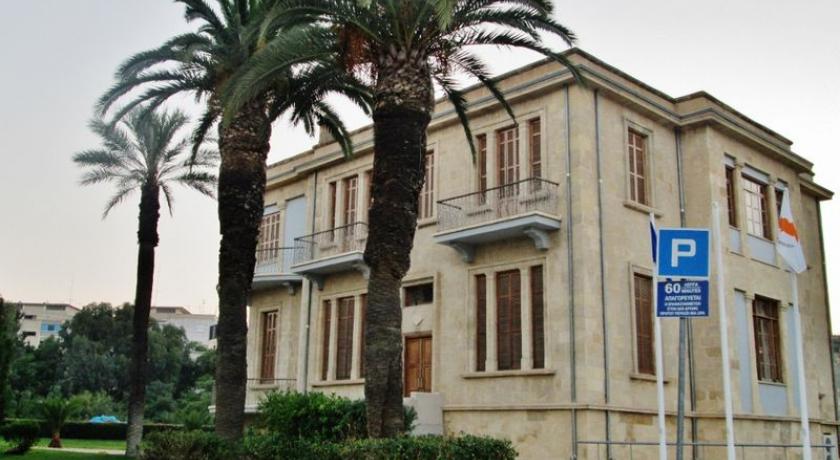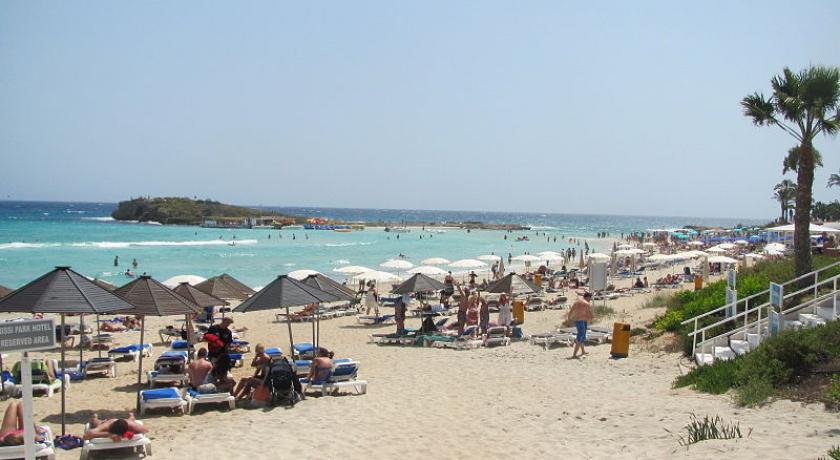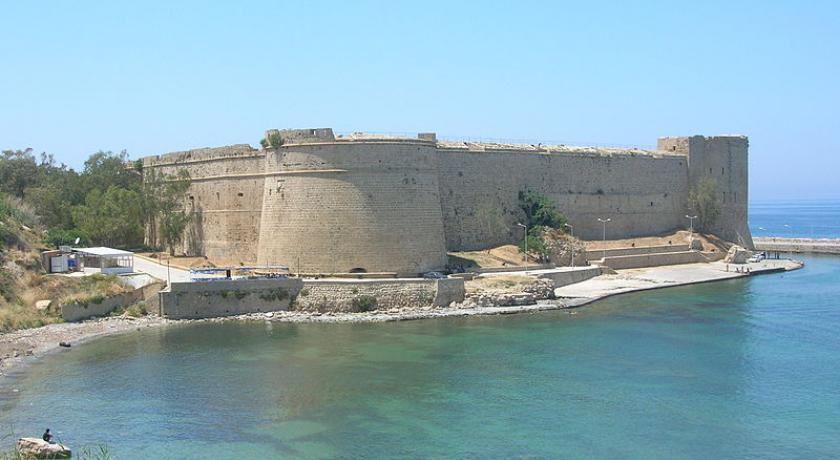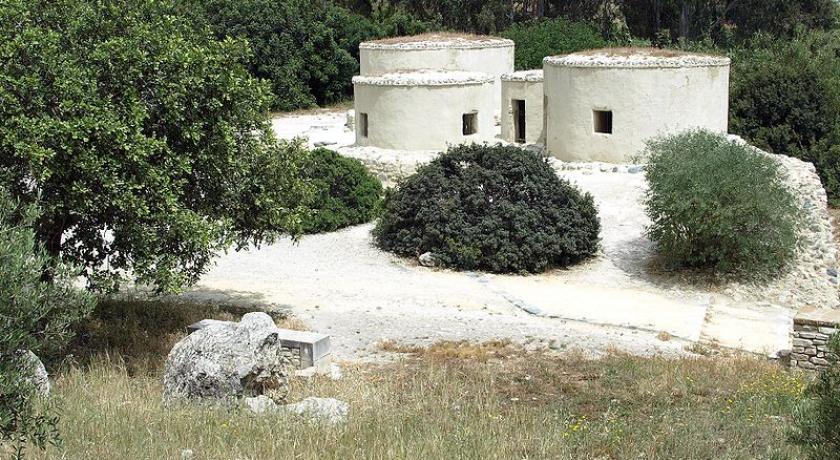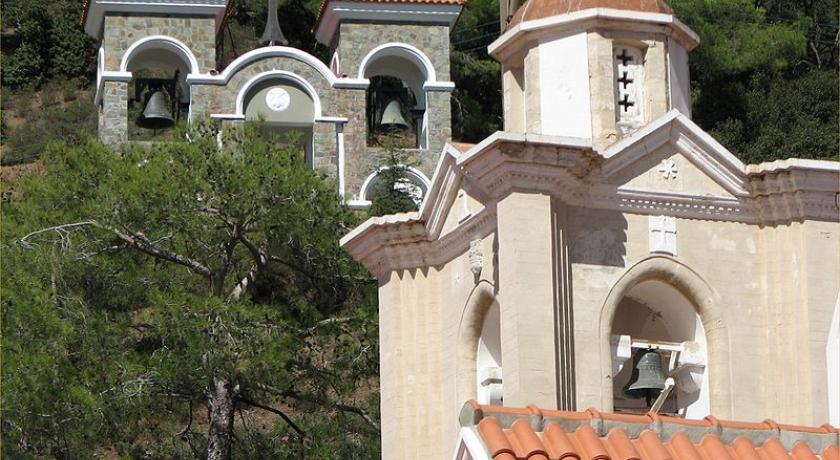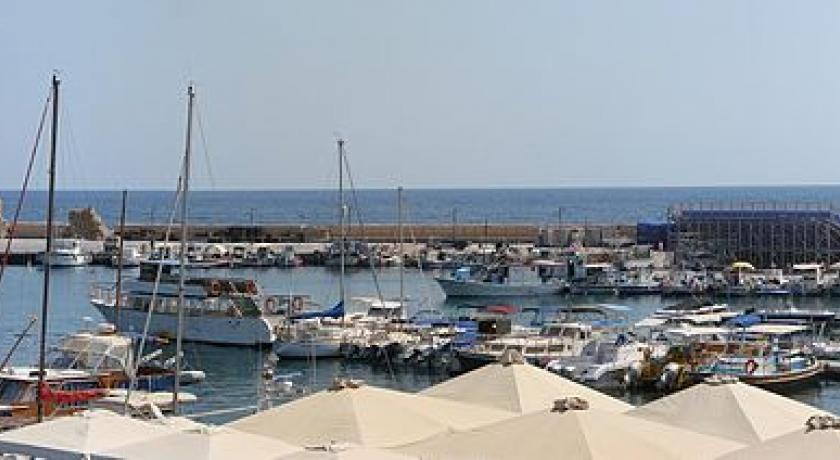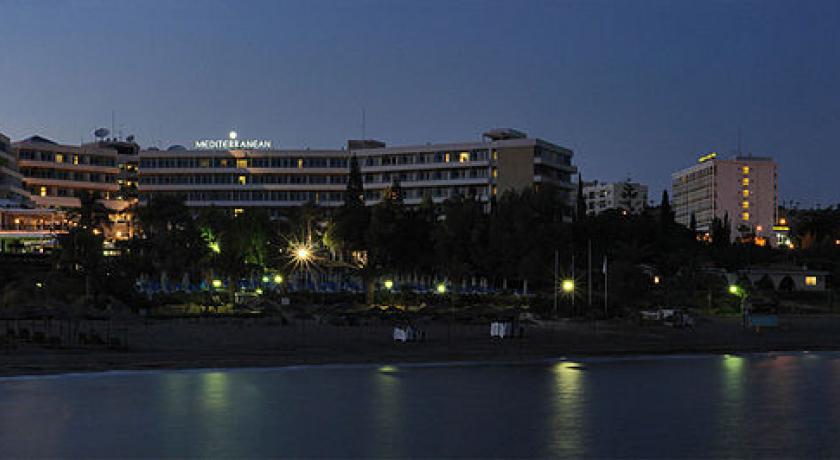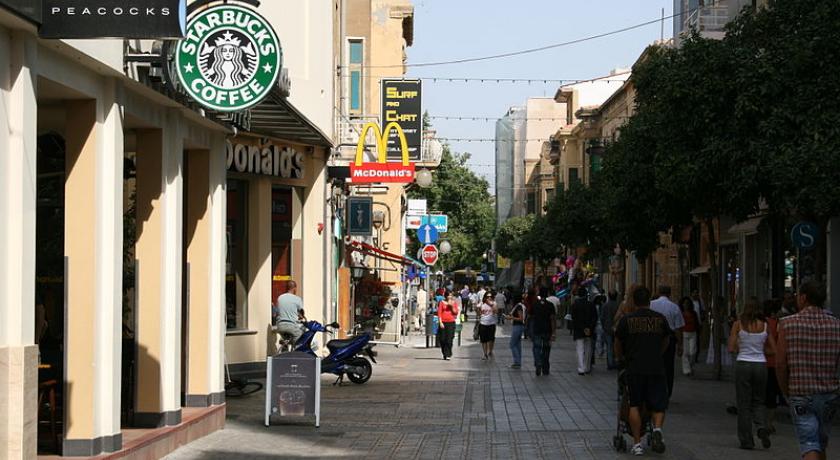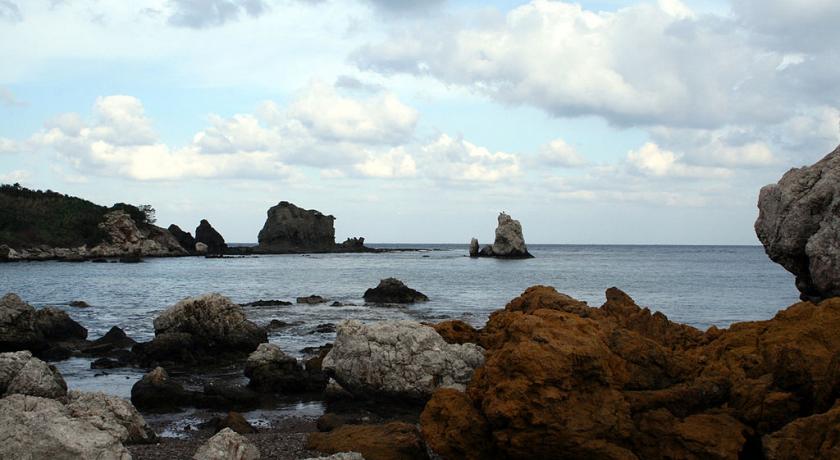Description
Cyprus, officially the Republic of Cyprus (Greek: Κυπριακή Δημοκρατία, translit. Kypriakí Demokratía; Turkish: Kıbrıs Cumhuriyeti), is an island country in the Eastern Mediterranean and the third largest and third most populous island in the Mediterranean. It is located south of Turkey, west of Syria and Lebanon, northwest of Israel and Palestine, north of Egypt, and southeast of Greece.
The earliest known human activity on the island dates to around the 10th millennium BC. Archaeological remains from this period include the well-preserved Neolithic village of Khirokitia, and Cyprus is home to some of the oldest water wells in the world. Cyprus was settled by Mycenaean Greeks in two waves in the 2nd millennium BC. As a strategic location in the Middle East, it was subsequently occupied by several major powers, including the empires of the Assyrians, Egyptians and Persians, from whom the island was seized in 333 BC by Alexander the Great. Subsequent rule by Ptolemaic Egypt, the Classical and Eastern Roman Empire, Arab caliphates for a short period, the French Lusignan dynasty and the Venetians, was followed by over three centuries of Ottoman rule between 1571 and 1878 (de jure until 1914).
Cyprus was placed under British administration based on Cyprus Convention in 1878 and formally annexed by Britain in 1914. While Turkish Cypriots made up 18% of the population, the partition of Cyprus and creation of a Turkish state in the north became a policy of Turkish Cypriot leaders and Turkey in the 1950s. Turkish leaders for a period advocated the annexation of Cyprus to Turkey as Cyprus was considered an "extension of Anatolia" by them; while since the 19th century, the majority Greek Cypriot population and its Orthodox church had been pursuing union with Greece, which became a Greek national policy in the 1950s. Following nationalist violence in the 1950s, Cyprus was granted independence in 1960. In 1963, the 11-year intercommunal violence between Greek Cypriots and Turkish Cypriots started, which displaced more than 25,000 Turkish Cypriots and brought the end of Turkish Cypriot representation in the republic. On 15 July 1974, a coup d'état was staged by Greek Cypriot nationalists and elements of the Greek military junta in an attempt at enosis, the incorporation of Cyprus into Greece. This action precipitated the Turkish invasion of Cyprus, which led to the capture of the present-day territory of Northern Cyprus the following month, after a ceasefire collapsed, and the displacement of over 150,000 Greek Cypriots and 50,000 Turkish Cypriots. A separate Turkish Cypriot state in the north was established by unilateral declaration in 1983; the move was widely condemned by the international community, with Turkey alone recognizing the new state. These events and the resulting political situation are matters of a continuing dispute.
The Cyprus Republic has de jure sovereignty over the island of Cyprus, as well as its territorial sea and exclusive economic area, according to international law (except for the British Overseas Territory of Akrotiri and Dhekelia, administered as Sovereign Base Areas, 2.8% of the territory). However, the Republic of Cyprus is de facto partitioned into two main parts: the area under the effective control of the Republic, located in the south and west, and comprising about 59% of the island's area; and the north, administered by the self-declared Turkish Republic of Northern Cyprus, covering about 36% of the island's area. Another nearly 4% of the island's area is covered by the UN buffer zone. The international community considers the northern part of the island as territory of the Republic of Cyprus occupied by Turkish forces.[25][26][27][28][29] The occupation is viewed as illegal under international law, amounting to illegal occupation of EU territory since Cyprus became a member of the European Union.
Cyprus is a major tourist destination in the Mediterranean.[31][32][33] With an advanced, high-income economy and a very high Human Development Index, the Republic of Cyprus has been a member of the Commonwealth since 1961 and was a founding member of the Non-Aligned Movement until it joined the European Union on 1 May 2004. On 1 January 2008, the Republic of Cyprus joined the eurozone.
Culture
Greek Cypriots and Turkish Cypriots share a lot in common in their culture but also have differences. Several traditional food (such as souvla and halloumi) and beverages are similar, as well as expressions and ways of life. Hospitality and buying or offering food and drinks for guests or others are common among both. In both communities, music, dance and art are integral parts of social life and many artistic, verbal and nonverbal expressions, traditional dances such as tsifteteli, similarities in dance costumes and importance placed on social activities are shared between the communities. However, the two communities have distinct religions and religious cultures, with the Greek Cypriots traditionally being Greek Orthodox and Turkish Cypriots traditionally being Sunni Muslims, which has partly hindered cultural exchange. Greek Cypriots have influences from Greece and Christianity, while Turkish Cypriots have influences from Turkey and Islam.
The Limassol Carnival Festival is an annual carnival which is held at Limassol, in Cyprus. The event which is very popular in Cyprus was introduced in the 20th century.
Arts
The art history of Cyprus can be said to stretch back up to 10,000 years, following the discovery of a series of Chalcolithic period carved figures in the villages of Khoirokoitia and Lempa. The island is the home to numerous examples of high quality religious icon painting from the Middle Ages as well as many painted churches. Cypriot architecture was heavily influenced by French Gothic and Italian renaissance introduced in the island during the era of Latin domination (1191–1571).
In modern times Cypriot art history begins with the painter Vassilis Vryonides (1883–1958) who studied at the Academy of Fine Arts in Venice. Arguably the two founding fathers of modern Cypriot art were Adamantios Diamantis (1900–1994) who studied at London's Royal College of Art and Christopheros Savva (1924–1968) who also studied in London, at Saint Martin's School of Art. In many ways these two artists set the template for subsequent Cypriot art and both their artistic styles and the patterns of their education remain influential to this day. In particular the majority of Cypriot artists still train in England while others train at art schools in Greece and local art institutions such as the Cyprus College of Art, University of Nicosia and the Frederick Institute of Technology.
One of the features of Cypriot art is a tendency towards figurative painting although conceptual art is being rigorously promoted by a number of art "institutions" and most notably the Nicosia Municipal Art Centre. Municipal art galleries exist in all the main towns and there is a large and lively commercial art scene. Cyprus was due to host the international art festival Manifesta in 2006 but this was cancelled at the last minute following a dispute between the Dutch organizers of Manifesta and the Cyprus Ministry of Education and Culture over the location of some of the Manifesta events in the Turkish sector of the capital Nicosia.
Other notable Greek Cypriot artists include Helene Black, Kalopedis family, Panayiotis Kalorkoti, Nicos Nicolaides, Stass Paraskos, Arestís Stasí, Telemachos Kanthos, Konstantia Sofokleous and Chris Achilleos, and Turkish Cypriot artists include İsmet Güney, Ruzen Atakan and Mutlu Çerkez.
Music
The traditional folk music of Cyprus has several common elements with Greek, Turkish, and Arabic music including Greco-Turkish dances such as the sousta, syrtos, zeibekikos, tatsia, and karsilamas as well as the Middle Eastern-inspired tsifteteli and arapies. There is also a form of musical poetry known as chattista which is often performed at traditional feasts and celebrations. The instruments commonly associated with Cyprus folk music are the bouzouki, oud ("outi"), violin ("fkiolin"), lute ("laouto"), accordion, Cyprus flute ("pithkiavlin") and percussion (including the "toumperleki"). Composers associated with traditional Cypriot music include Evagoras Karageorgis, Marios Tokas, Solon Michaelides and Savvas Salides. Among musicians is also the acclaimed pianist Cyprien Katsaris and composer and artistic director of the European Capital of Culture initiative Marios Joannou Elia.
Popular music in Cyprus is generally influenced by the Greek Laïka scene; artists who play in this genre include international platinum star Anna Vissi,[217][218][219][220] Evridiki, and Sarbel. Hip Hop, R&B and reggae have been supported by the emergence of Cypriot rap and the urban music scene at Ayia Napa. Cypriot rock music and Éntekhno rock is often associated with artists such as Michalis Hatzigiannis and Alkinoos Ioannidis. Metal also has a small following in Cyprus represented by bands such as Armageddon (rev.16:16), Blynd, Winter's Verge, Methysos and Quadraphonic.
Literature
Literary production of the antiquity includes the Cypria, an epic poem, probably composed in the late 7th century BC and attributed to Stasinus. The Cypria is one of the very first specimens of Greek and European poetry. The Cypriot Zeno of Citium was the founder of the Stoic School of Philosophy.
Epic poetry, notably the "acritic songs", flourished during Middle Ages. Two chronicles, one written by Leontios Machairas and the other by Georgios Voustronios, cover the entire Middle Ages until the end of Frankish rule (4th century–1489). Poèmes d'amour written in medieval Greek Cypriot date back from the 16th century. Some of them are actual translations of poems written by Petrarch, Bembo, Ariosto and G. Sannazzaro. Many Cypriot scholars fled Cyprus at troubled times such as Ioannis Kigalas (c. 1622–1687) who migrated from Cyprus to Italy in the 17th century, several of his works have survived in books of other scholars.
Hasan Hilmi Efendi, a Turkish Cypriot poet, was rewarded by the Ottoman sultan Mahmud II and said to be the "sultan of the poems".
Modern Greek Cypriot literary figures include the poet and writer Kostas Montis, poet Kyriakos Charalambides, poet Michalis Pasiardis, writer Nicos Nicolaides, Stylianos Atteshlis, Altheides, Loukis Akritas and Demetris Th. Gotsis. Dimitris Lipertis, Vasilis Michaelides and Pavlos Liasides are folk poets who wrote poems mainly in the Cypriot-Greek dialect. Among leading Turkish Cypriot writers are Osman Türkay, twice nominated for the Nobel Prize in Literature, Özker Yaşın, Neriman Cahit, Urkiye Mine Balman, Mehmet Yaşın and Neşe Yaşın.
There is an increasingly strong presence of both temporary and permanent emigre Cypriot writers in world literature, as well as writings by second and third -generation Cypriot writers born or raised abroad, often writing in English. This includes writers such as Stephen Laughton, Michael Paraskos, Stel Pavlou and Stephanos Stephanides.
Examples of Cyprus in foreign literature include the works of Shakespeare, with most of the play Othello by William Shakespeare set on the island of Cyprus. British writer Lawrence Durrell lived in Cyprus from 1952 until 1956, during his time working for the British colonial government on the island, and wrote the book Bitter Lemons about his time in Cyprus which won the second Duff Cooper Prize in 1957. More recently British writer Victoria Hislop used Cyprus as the setting for her 2014 novel The Sunrise.
Cuisine
Halloumi cheese originated in Cyprus and was initially made during the Medieval Byzantine period.[238] Halloumi (Hellim) is commonly served sliced, either fresh or grilled, as an appetiser.
Seafood and fish dishes include squid, octopus, red mullet, and sea bass. Cucumber and tomato are used widely in salads. Common vegetable preparations include potatoes in olive oil and parsley, pickled cauliflower and beets, asparagus and taro. Other traditional delicacies of are meat marinated in dried coriander seeds and wine, and eventually dried and smoked, such as lountza (smoked pork loin), charcoal-grilled lamb, souvlaki (pork and chicken cooked over charcoal), and sheftalia (minced meat wrapped in mesentery). Pourgouri (bulgur, cracked wheat) is the traditional source of carbohydrate other than bread, and is used to make the delicacy koubes.
Fresh vegetables and fruits are common ingredients. Frequently used vegetables include courgettes, green peppers, okra, green beans, artichokes, carrots, tomatoes, cucumbers, lettuce and grape leaves, and pulses such as beans, broad beans, peas, black-eyed beans, chick-peas and lentils. The most common fruits and nuts are pears, apples, grapes, oranges, mandarines, nectarines, medlar, blackberries, cherry, strawberries, figs, watermelon, melon, avocado, lemon, pistachio, almond, chestnut, walnut, and hazelnut.
Cyprus is also well known for its desserts, including lokum (also known as Turkish Delight) and Soutzoukos. This island has protected geographical indication (PGI) for its lokum produced in the village of Geroskipou.
History
Prehistoric and Ancient Cyprus
The earliest confirmed site of human activity on Cyprus is Aetokremnos, situated on the south coast, indicating that hunter-gatherers were active on the island from around 10,000 BC, with settled village communities dating from 8200 BC. The arrival of the first humans correlates with the extinction of the dwarf hippos and dwarf elephants. Water wells discovered by archaeologists in western Cyprus are believed to be among the oldest in the world, dated at 9,000 to 10,500 years old.
Remains of an 8-month-old cat were discovered buried with a human body at a separate Neolithic site in Cyprus. The grave is estimated to be 9,500 years old (7500 BC), predating ancient Egyptian civilisation and pushing back the earliest known feline-human association significantly. The remarkably well-preserved Neolithic village of Khirokitia is a UNESCO World Heritage Site dating to approximately 6800 BC.
During the late Bronze Age the island experienced two waves of Greek settlement. The first wave consisted of Mycenaean Greek traders who started visiting Cyprus around 1400 BC. A major wave of Greek settlement is believed to have taken place following the Bronze Age collapse of Mycenaean Greece from 1100 to 1050 BC, with the island's predominantly Greek character dating from this period. Cyprus occupies an important role in Greek mythology being the birthplace of Aphrodite and Adonis, and home to King Cinyras, Teucer and Pygmalion. Beginning in the 8th century BC Phoenician colonies were founded on the south coast of Cyprus, near present-day Larnaca and Salamis.
Cyprus is at a strategic location in the Middle East. It was ruled by Assyria for a century starting in 708 BC, before a brief spell under Egyptian rule and eventually Persian rule in 545 BC. The Cypriots, led by Onesilus, king of Salamis, joined their fellow Greeks in the Ionian cities during the unsuccessful Ionian Revolt in 499 BC against the Achaemenid Empire. The revolt was suppressed, but Cyprus managed to maintain a high degree of autonomy and remained oriented towards the Greek world.
The island was conquered by Alexander the Great in 333 BC. Following his death and the subsequent division of his empire and wars among his successors, Cyprus became part of the Hellenistic empire of Ptolemaic Egypt. It was during this period that the island was fully Hellenized. In 58 BC Cyprus was acquired by the Roman Republic.
Middle Ages
When the Roman Empire was divided into Eastern and Western parts in 395, Cyprus became part of the East Roman, or Byzantine Empire, and would remain so until the Crusades some 800 years later. Under Byzantine rule, the Greek orientation that had been prominent since antiquity developed the strong Hellenistic-Christian character that continues to be a hallmark of the Greek Cypriot community.
Beginning in 649, Cyprus suffered from devastating raids launched by Muslim armies from the Levant, which continued for the next 300 years. Many were quick piratical raids, but others were large-scale attacks in which many Cypriots were slaughtered and great wealth carried off or destroyed.
There are no Byzantine churches which survive from this period; thousands of people were killed, and many cities – such as Salamis – were destroyed and never rebuilt. Byzantine rule was restored in 965, when Emperor Nikephoros II Phokas scored decisive victories on land and sea.
In 1191, during the Third Crusade, Richard I of England captured the island from Isaac Komnenos of Cyprus He used it as a major supply base that was relatively safe from the Saracens. A year later Richard sold the island to the Knights Templar, who, following a bloody revolt, in turn sold it to Guy of Lusignan. His brother and successor Aimery was recognised as King of Cyprus by Henry VI, Holy Roman Emperor.
Following the death in 1473 of James II, the last Lusignan king, the Republic of Venice assumed control of the island, while the late king's Venetian widow, Queen Catherine Cornaro, reigned as figurehead. Venice formally annexed the Kingdom of Cyprus in 1489, following the abdication of Catherine. The Venetians fortified Nicosia by building the Walls of Nicosia, and used it as an important commercial hub. Throughout Venetian rule, the Ottoman Empire frequently raided Cyprus. In 1539 the Ottomans destroyed Limassol and so fearing the worst, the Venetians also fortified Famagusta and Kyrenia.
Although the Lusignan French aristocracy remained the dominant social class in Cyprus throughout the medieval period, the former assumption that Greeks were treated only as serfs on the island is no longer considered by academics to be accurate. It is now accepted that the medieval period saw increasing numbers of Greek Cypriots elevated to the upper classes, a growing Greek middle ranks, and the Lusignan royal household even marrying Greeks. This included King John II of Cyprus who married Helena Palaiologina.
Cyprus under the Ottoman Empire
In 1570, a full-scale Ottoman assault with 60,000 troops brought the island under Ottoman control, despite stiff resistance by the inhabitants of Nicosia and Famagusta. Ottoman forces capturing Cyprus massacred many Greek and Armenian Christian inhabitants. The previous Latin elite were destroyed and the first significant demographic change since antiquity took place with the formation of a Muslim community. Soldiers who fought in the conquest settled on the island and Turkish peasants and craftsmen were brought to the island from Anatolia. This new community also included banished Anatolian tribes, "undesirable" persons and members of various "troublesome" Muslim sects, as well as a number of new converts on the island.
The Ottomans abolished the feudal system previously in place and applied the millet system to Cyprus, under which non-Muslim peoples were governed by their own religious authorities. In a reversal from the days of Latin rule, the head of the Church of Cyprus was invested as leader of the Greek Cypriot population and acted as mediator between Christian Greek Cypriots and the Ottoman authorities. This status ensured that the Church of Cyprus was in a position to end the constant encroachments of the Roman Catholic Church. Ottoman rule of Cyprus was at times indifferent, at times oppressive, depending on the temperaments of the sultans and local officials, and the island began over 250 years of economic decline.
The ratio of Muslims to Christians fluctuated throughout the period of Ottoman domination. In 1777–78, 47,000 Muslims constituted a majority over the island's 37,000 Christians. By 1872, the population of the island had risen to 144,000, comprising 44,000 Muslims and 100,000 Christians. The Muslim population included numerous crypto-Christians, including the Linobambaki, a crypto-Catholic community that arose due to religious persecution of the Catholic community by the Ottoman authorities; this community would assimilate into the Turkish Cypriot community during British rule.
As soon as the Greek War of Independence broke out in 1821, several Greek Cypriots left for Greece to join the Greek forces. In response, the Ottoman governor of Cyprus arrested and executed 486 prominent Greek Cypriots, including the Archbishop of Cyprus, Kyprianos, and four other bishops. In 1828, modern Greece's first president Ioannis Kapodistrias called for union of Cyprus with Greece, and numerous minor uprisings took place.[73] Reaction to Ottoman misrule led to uprisings by both Greek and Turkish Cypriots, although none were successful. After centuries of neglect by the Turks, the unrelenting poverty of most of the people, and the ever-present tax collectors fuelled Greek nationalism, and by the 20th century idea of enosis, or union, with newly independent Greece was firmly rooted among Greek Cypriots.
Numeracy
Under the Ottoman rule, numeracy, school enrollment and literacy rates were all low. In some countries, these low levels of human capital level persisted sometime after Ottoman rule ended. Greece and Cyprus were no exception, they faced the same issue of paths taken under Ottoman educational policies. In these two countries (Greece and Cyprus), numeracy increased rapidly during the twentieth century.
Cyprus under the British Empire
In the aftermath of the Russo-Turkish War (1877–1878) and the Congress of Berlin, Cyprus was leased to the British Empire which de facto took over its administration in 1878 (though, in terms of sovereignty, Cyprus remained a de jure Ottoman territory until 5 November 1914, together with Egypt and Sudan) in exchange for guarantees that Britain would use the island as a base to protect the Ottoman Empire against possible Russian aggression.
The island would serve Britain as a key military base for its colonial routes. By 1906, when the Famagusta harbour was completed, Cyprus was a strategic naval outpost overlooking the Suez Canal, the crucial main route to India which was then Britain's most important overseas possession. Following the outbreak of the First World War and the decision of the Ottoman Empire to join the war on the side of the Central Powers, on 5 November 1914 the British Empire formally annexed Cyprus and declared the Ottoman Khedivate of Egypt and Sudan a Sultanate and British protectorate.
In 1915, Britain offered Cyprus to Constantine I of Greece on condition that Greece join the war on the side of the British, which he declined. In 1923, under the Treaty of Lausanne, the nascent Turkish republic relinquished any claim to Cyprus, and in 1925 it was declared a British crown colony. Many Greek and Turkish Cypriots fought in the British Army during both world wars. During the Second World War, many enlisted in the Cyprus Regiment.
The Greek Cypriot population, meanwhile, had become hopeful that the British administration would lead to enosis. The idea of enosis was historically part of the Megali Idea, a greater political ambition of a Greek state encompassing the territories with Greek inhabitants in the former Ottoman Empire, including Cyprus and Asia Minor with a capital in Constantinople, and was actively pursued by the Cypriot Orthodox Church, which had its members educated in Greece. These religious officials, together with Greek military officers and professionals, some of whom still pursued the Megali Idea, would later found the guerrilla organisation Ethniki Organosis Kyprion Agoniston or National Organisation of Cypriot Fighters (EOKA). The Greek Cypriots viewed the island as historically Greek and believed that union with Greece was a natural right. In the 1950s, the pursuit of enosis became a part of the Greek national policy,
Initially, the Turkish Cypriots favoured the continuation of the British rule. However, they were alarmed by the Greek Cypriot calls for enosis as they saw the union of Crete with Greece, which led to the exodus of Cretan Turks, as a precedent to be avoided, and they took a pro-partition stance in response to the militant activity of EOKA. The Turkish Cypriots also viewed themselves as a distinct ethnic group of the island and believed in their having a separate right to self-determination from Greek Cypriots. Meanwhile, in the 1950s, Turkish leader Menderes considered Cyprus an "extension of Anatolia", rejected the partition of Cyprus along ethnic lines and favoured the annexation of the whole island to Turkey. Nationalistic slogans centred on the idea that "Cyprus is Turkish" and the ruling party declared Cyprus to be a part of the Turkish homeland that was vital to its security. Upon realising the fact that the Turkish Cypriot population was only 20% of the islanders made annexation unfeasible, the national policy was changed to favour partition. The slogan "Partition or Death" was frequently used in Turkish Cypriot and Turkish protests starting in the late 1950s and continuing throughout the 1960s. Although after the Zürich and London conferences Turkey seemed to accept the existence of the Cypriot state and to distance itself from its policy of favouring the partition of the island, the goal of the Turkish and Turkish Cypriot leaders remained that of creating an independent Turkish state in the northern part of the island.
In January 1950, the Church of Cyprus organised a referendum under the supervision of clerics and with no Turkish Cypriot participation, where 96% of the participating Greek Cypriots voted in favour of enosis, The Greeks were 80.2% of the total island' s population at the time (census 1946). Restricted autonomy under a constitution was proposed by the British administration but eventually rejected. In 1955 the EOKA organisation was founded, seeking union with Greece through armed struggle. At the same time the Turkish Resistance Organisation (TMT), calling for Taksim, or partition, was established by the Turkish Cypriots as a counterweight. The British had also adopted at the time a policy of "divide and rule". Woodhouse, a British official in Cyprus, revealed that then British Foreign Secretary Harold Macmillan "urged the Britons in Cyprus to stir up the Turks in order to neutralise Greek agitation". British officials also tolerated the creation of the Turkish underground organisation T.M.T. The Secretary of State for the Colonies in a letter dated 15 July 1958 had advised the Governor of Cyprus not to act against T.M.T despite its illegal actions so as not to harm British relations with the Turkish government.
Independence and inter-communal violence
On 16 August 1960, Cyprus attained independence after the Zürich and London Agreement between the United Kingdom, Greece and Turkey. Cyprus had a total population of 573,566; of whom 442,138 (77.1%) were Greeks, 104,320 (18.2%) Turks, and 27,108 (4.7%) others. The UK retained the two Sovereign Base Areas of Akrotiri and Dhekelia, while government posts and public offices were allocated by ethnic quotas, giving the minority Turkish Cypriots a permanent veto, 30% in parliament and administration, and granting the three mother-states guarantor rights.
However, the division of power as foreseen by the constitution soon resulted in legal impasses and discontent on both sides, and nationalist militants started training again, with the military support of Greece and Turkey respectively. The Greek Cypriot leadership believed that the rights given to Turkish Cypriots under the 1960 constitution were too extensive and designed the Akritas plan, which was aimed at reforming the constitution in favour of Greek Cypriots, persuading the international community about the correctness of the changes and violently subjugating Turkish Cypriots in a few days should they not accept the plan.Tensions were heightened when Cypriot President Archbishop Makarios III called for constitutional changes, which were rejected by Turkey and opposed by Turkish Cypriots.
Intercommunal violence erupted on 21 December 1963, when two Turkish Cypriots were killed at an incident involving the Greek Cypriot police. The violence resulted in the death of 364 Turkish and 174 Greek Cypriots, destruction of 109 Turkish Cypriot or mixed villages and displacement of 25,000–30,000 Turkish Cypriots. The crisis resulted in the end of the Turkish Cypriot involvement in the administration and their claiming that it had lost its legitimacy; the nature of this event is still controversial. In some areas, Greek Cypriots prevented Turkish Cypriots from travelling and entering government buildings, while some Turkish Cypriots willingly withdrew due to the calls of the Turkish Cypriot administration.Turkish Cypriots started living in enclaves; the republic's structure was changed, unilaterally, by Makarios and Nicosia was divided by the Green Line, with the deployment of UNFICYP troops.
In 1964, Turkey tried to invade Cyprus in response to the continuing Cypriot intercommunal violence. But Turkey was stopped by a strongly worded telegram from the US President Lyndon B. Johnson on 5 June, warning that the US would not stand beside Turkey in case of a consequential Soviet invasion of Turkish territory. Meanwhile, by 1964, enosis was a Greek policy that could not be abandoned; Makarios and the Greek prime minister Georgios Papandreou agreed that enosis should be the ultimate aim and King Constantine wished Cyprus "a speedy union with the mother country". Greece dispatched 10,000 troops to Cyprus to counter a possible Turkish invasion.
1974 coup, Turkish invasion and division
On 15 July 1974, the Greek military junta under Dimitrios Ioannides carried out a coup d'état in Cyprus, to unite the island with Greece. The coup ousted president Makarios III and replaced him with pro-enosis nationalist Nikos Sampson. In response to the coup,[103][104][105][106][107] five days later, on 20 July 1974, the Turkish army invaded the island, citing a right to intervene to restore the constitutional order from the 1960 Treaty of Guarantee. This justification has been rejected by the United Nations and the international community.
The Turkish air force began bombing Greek positions in Cyprus, and hundreds of paratroopers were dropped in the area between Nicosia and Kyrenia, where well-armed Turkish Cypriot enclaves had been long-established; while off the Kyrenia coast, Turkish troop ships landed 6,000 men as well as tanks, trucks and armoured vehicles.
Three days later, when a ceasefire had been agreed, Turkey had landed 30,000 troops on the island and captured Kyrenia, the corridor linking Kyrenia to Nicosia, and the Turkish Cypriot quarter of Nicosia itself. The junta in Athens, and then the Sampson regime in Cyprus fell from power. In Nicosia, Glafkos Clerides assumed the presidency and constitutional order was restored, removing the pretext for the Turkish invasion. But after the peace negotiations in Geneva, the Turkish government reinforced their Kyrenia bridgehead and started a second invasion on 14 August. The invasion resulted in the seizure of Morphou, Karpass, Famagusta and the Mesaoria.
International pressure led to a ceasefire, and by then 36% of the island had been taken over by the Turks and 180,000 Greek Cypriots had been evicted from their homes in the north. At the same time, around 50,000 Turkish Cypriots moved to the areas under the control of the Turkish Forces and settled in the properties of the displaced Greek Cypriots. Among a variety of sanctions against Turkey, in mid-1975 the US Congress imposed an arms embargo on Turkey for using American-supplied equipment during the Turkish invasion of Cyprus in 1974. There are 1,534 Greek Cypriots and 502 Turkish Cypriots[ missing as a result of the fighting.
Post-division
After the restoration of constitutional order and the return of Archbishop Makarios III to Cyprus in December 1974, Turkish troops remained, occupying the northeastern portion of the island. In 1983, the Turkish Cypriot leader proclaimed the Turkish Republic of Northern Cyprus (TRNC), which is recognised only by Turkey.
The events of the summer of 1974 dominate the politics on the island, as well as Greco-Turkish relations. Around 150,000 settlers from Turkey are believed to be living in the north—many of whom were forced from Turkey by the Turkish government—in violation of the Geneva Convention and various UN resolutions.
The Turkish invasion, the ensuing occupation and the declaration of independence by the TRNC have been condemned by United Nations resolutions, which are reaffirmed by the Security Council every year. The last major effort to settle the Cyprus dispute was the Annan Plan in 2004, drafted by the then Secretary General, Kofi Annan. The plan was put to a referendum in both Northern Cyprus and the Republic of Cyprus. 65% of Turkish Cypriots voted in support of the plan and 74% Greek Cypriots voted against the plan, claiming that it disproportionately favoured the Turkish side. In total, 66.7% of the voters rejected the Annan Plan V. On 1 May 2004 Cyprus joined the European Union, together with nine other countries. Cyprus was accepted into the EU as a whole, although the EU legislation is suspended in Northern Cyprus until a final settlement of the Cyprus problem. In July 2006, the island served as a haven for people fleeing Lebanon, due to the conflict between Israel and Hezbollah (also called "The July War").
Efforts have been made to enhance freedom of movement between the two sides. In April 2003, Northern Cyprus unilaterally eased border restrictions, permitting Cypriots to cross between the two sides for the first time in 30 years. In March 2008, a wall that had stood for decades at the boundary between the Republic of Cyprus and the UN buffer zone was demolished. The wall had cut across Ledra Street in the heart of Nicosia and was seen as a strong symbol of the island's 32-year division. On 3 April 2008, Ledra Street was reopened in the presence of Greek and Turkish Cypriot officials. North and South relaunched reunification talks on 15 May 2015.
Geography
Cyprus is the third largest island in the Mediterranean Sea, after the Italian islands of Sicily and Sardinia (both in terms of area and population). It is also the world's 80th largest by area and world's 51st largest by population. It measures 240 kilometres (149 mi) long from end to end and 100 kilometres (62 mi) wide at its widest point, with Turkey 75 kilometres (47 mi) to the north.
Other neighbouring territories include Syria and Lebanon to the east (105 and 108 kilometres (65 and 67 mi), respectively), Israel 200 kilometres (124 mi) to the southeast, Egypt 380 kilometres (236 mi) to the south, and Greece to the northwest: 280 kilometres (174 mi) to the small Dodecanesian island of Kastellorizo (Megisti), 400 kilometres (249 mi) to Rhodes and 800 kilometres (497 mi) to the Greek mainland. Sources alternatively place Cyprus in Europe, or Western Asia and the Middle East.
The physical relief of the island is dominated by two mountain ranges, the Troodos Mountains and the smaller Kyrenia Range, and the central plain they encompass, the Mesaoria. The Mesaoria plain is drained by the Pedieos River, the longest on the island. The Troodos Mountains cover most of the southern and western portions of the island and account for roughly half its area. The highest point on Cyprus is Mount Olympus at 1,952 m (6,404 ft), located in the centre of the Troodos range. The narrow Kyrenia Range, extending along the northern coastline, occupies substantially less area, and elevations are lower, reaching a maximum of 1,024 m (3,360 ft). The island lies within the Anatolian Plate.
Geopolitically, the island is subdivided into four main segments. The Republic of Cyprus occupies the southern two-thirds of the island (59.74%). The Turkish Republic of Northern Cyprus occupies the northern third (34.85%), and the United Nations-controlled Green Line provides a buffer zone that separates the two and covers 2.67% of the island. Lastly, two bases under British sovereignty are located on the island: Akrotiri and Dhekelia, covering the remaining 2.74%.
Climate
Cyprus has a subtropical climate – Mediterranean and semi-arid type (in the north-eastern part of the island) – Köppen climate classifications Csa and BSh, with very mild winters (on the coast) and warm to hot summers. Snow is possible only in the Troodos Mountains in the central part of island. Rain occurs mainly in winter, with summer being generally dry.
Cyprus has one of the warmest climates in the Mediterranean part of the European Union. The average annual temperature on the coast is around 24 °C (75 °F) during the day and 14 °C (57 °F) at night. Generally, summers last about eight months, beginning in April with average temperatures of 21–23 °C (70–73 °F) during the day and 11–13 °C (52–55 °F) at night, and ending in November with average temperatures of 22–23 °C (72–73 °F) during the day and 12–14 °C (54–57 °F) at night, although in the remaining four months temperatures sometimes exceed 20 °C (68 °F).
Among all cities in the Mediterranean part of the European Union, Limassol has one of the warmest winters, in the period January – February average temperature is 17–18 °C (63–64 °F) during the day and 7–8 °C (45–46 °F) at night, in other coastal locations in Cyprus is generally 16–17 °C (61–63 °F) during the day and 6–8 °C (43–46 °F) at night. During March, Limassol has average temperatures of 19–20 °C (66–68 °F) during the day and 9–11 °C (48–52 °F) at night, in other coastal locations in Cyprus is generally 17–19 °C (63–66 °F) during the day and 8–10 °C (46–50 °F) at night.
The middle of summer is hot – in July and August on the coast the average temperature is usually around 33 °C (91 °F) during the day and around 22 °C (72 °F) at night (inland, in the highlands average temperature exceeds 35 °C (95 °F)) while in the June and September on the coast the average temperature is usually around 30 °C (86 °F) during the day and around 20 °C (68 °F) at night in Limassol, while is usually around 28 °C (82 °F) during the day and around 18 °C (64 °F) at night in Paphos. Large fluctuations in temperature are rare. Inland temperatures are more extreme, with colder winters and hotter summers compared with the coast of the island.
Average annual temperature of sea is 21–22 °C (70–72 °F), from 17 °C (63 °F) in February to 27–28 °C (81–82 °F) in August (depending on the location). In total 7 months – from May to November – the average sea temperature exceeds 20 °C (68 °F).
Sunshine hours on the coast are around 3,200 per year, from an average of 5–6 hours of sunshine per day in December to an average of 12–13 hours in July.This is about double that of cities in the northern half of Europe; for comparison, London receives about 1,540 per year. In December, London receives about 50 hours of sunshine while coastal locations in Cyprus about 180 hours (almost as much as in May in London).
Religion
The majority of Greek Cypriots identify as Greek Orthodox, whereas most Turkish Cypriots are adherents of Sunni Islam. According to Eurobarometer 2005, Cyprus was the second most religious state in the European Union at that time, after Malta (although in 2005 Romania wasn't in the European Union; currently Romania is the most religious state in the European Union) (see Religion in the European Union). The first President of Cyprus, Makarios III, was an archbishop. The current leader of the Greek Orthodox Church of Cyprus is Archbishop Chrysostomos II.
Hala Sultan Tekke, situated near the Larnaca Salt Lake, is considered by some secular orientalists as the third holiest site in Sunni Islam and an object of pilgrimage for both Muslims and Christians.
According to the 2001 census carried out in the Government-controlled area, 94.8% of the population are Eastern Orthodox, 0.9% Armenians and Maronites, 1.5% Roman Catholics, 1.0% Church of England, and 0.6% Muslims. There is also a Jewish community on Cyprus. The remaining 1.3% adhere to other religious denominations or did not state their religion.
Languages
Cyprus has two official languages, Greek and Turkish. Armenian and Cypriot Maronite Arabic are recognised as minority languages. Although without official status, English is widely spoken and it features widely on road signs, public notices, and in advertisements, etc. English was the sole official language during British colonial rule and the lingua franca until 1960, and continued to be used (de facto) in courts of law until 1989 and in legislation until 1996. 80.4% of Cypriots are proficient in the English language as a second language. Russian is widely spoken among the country's minorities, residents and citizens of post-Soviet countries, and Pontic Greeks. Russian, after English and Greek, is the third language used on many signs of shops and restaurants, particularly in Limassol and Paphos. In addition to these languages, 12% speak French and 5% speak German.
The everyday spoken language of Greek Cypriots is Cypriot Greek and that of Turkish Cypriots is Cypriot Turkish. These vernaculars both differ from their standard registers significantly.
source https://en.wikipedia.org/wiki/Cyprus
Address
Chypre
Cyprus
Lat: 35.126411438 - Lng: 33.429859161


